The great horned owl, also known as bubo virginianus, is part of the Strigidae family and it’s considered a true owl. Another commonly known name for this creature is the tiger owl, which early naturalists originally described as a “Tiger of the Air” or “Winged Tiger”. Still, other individuals have nicknamed this large American owl the hoot owl.
Typically speaking, this large bird that is native to North America is highly adaptable. It has a wide range and out of all of the true owls, the great horned owl is distributed the most widely. It has a wide-ranging diet of small and medium-sized mammals and many compare it to the Eurasian Eagle-owl because of its large size and similar appearance.
Even more importantly, I’m going to share other interesting facts and necessary information to learn about the great horned owl. I’ll cover a range of important topics that include:
- Facts about great horned owls
- The best ways to identify great horned owls
- The differences between males and females
- Feeding and diet preferences of great horned owls
- Behaviors and nesting habits
- and other topics
Continue reading to discover the truth about important facts regarding great horned owls.
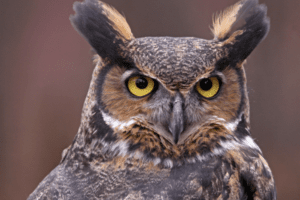
Great Horned Owl Bird Facts
- Common Name: Great Horned Owl
- Scientific Name: Bubo virginianus
- Scientific Family: Strigidae
- Life Span: 13 years
- Size: 17 to 25 inches
- Wingspan: 36 to 60 inches
- Weight: 43.2 to 88.0 oz
- Conservation status: Least Concern
How To Identify Great Horned Owls
The easiest way to identify a great horned owl is to know that they are nocturnal creatures with reddish-brown faces and feathers that are made up of mottled gray-brown color. They also have a very bright white patch that covers their throat.
Their colors and overall tone change depending on the region the owl is located in. Their colorful appearance could go anywhere from pale to sooty depending on the area.
Differences Between Male & Female
First off, one thing to note is that male and female great horned owls both have horns. But the horns themselves are actually feathers, which is an interesting fact. So, from a physical appearance standpoint, they both look relatively similar.
But there is a difference in size. The females of the species are actually larger than the males. Although, the male great horned owls have a larger voice box than females. This makes the calls from the mail owls much deeper than their female counterparts.
Male and female great horned owl pairs typically call together. It’s easy to notice the differences in pitch, which proves the mail has a much deeper call than his mate.
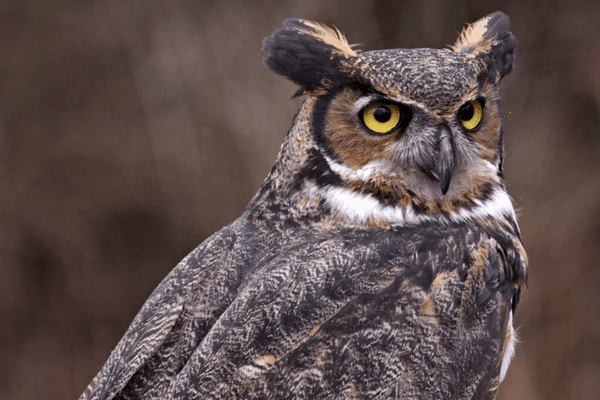
Differences In Summer Plumage vs Winter Plumage
The main difference in plumage happens regionally. It’s mainly the color pattern of the owls that changes.
The color tone in the Pacific Northwest, as an example, tends to achieve a dark sooty consistency. In the Southwest, the great horned owls typically have grayer and paler coloration in their feathers. Canadian great horned owls almost appear white in coloration.
Related article: 10 Best Live Owl Cams Online: 24/7 Live Streaming
Where You’ll See A Great Horned Owl
Birdwatchers can rejoice because great horned owls are the most prominent owl in the United States and Canada. They live all throughout North America and they populate every state in the US. So, you will not have to travel very far to spot your favorite nocturnal creature.
They live in a wide range of habitats, so they’re fairly easy to find. In urban settings, you can find them in parks, suburbs, orchards, and cities. They also tend to live in tropical rainforests, tundra edges, deserts, swamps, and evergreen forests as well.
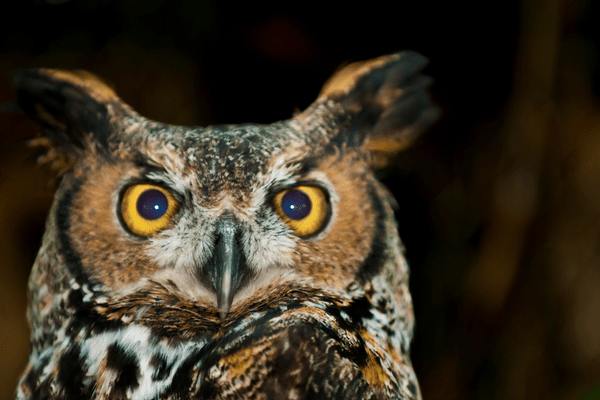
Great Horned Owl Migration Patterns
Again, as far as their migration patterns are concerned, the great horned owl is easy to find in the US and Canada because they live everywhere in these regions. The least populated areas are further in northern Canada where it’s freezing cold. They tend to stick to agricultural areas and open woodlands when possible and avoid ranging in the boreal forests far to the north.
Diet and Feeding Preferences
The great horned owl eats a wide range of small to medium-size prey including many mammals. Their diet typically consists of:
- Rabbits
- Rats
- Skunks
- Ground squirrels
- Mice
- Opossums
- Hawks
- Ducks
- Geese
- Scorpions
- Frogs
- Insects
- Lizards
- Snakes
- Occasional fish
Unfortunately for owl enthusiasts, great horned owls do not consume birdseed. So, your bird feeders aren’t going to attract this majestic creature to your home.
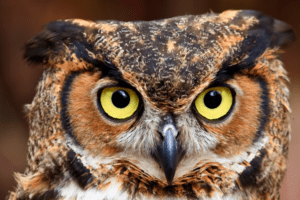
Great Horned Owl Nesting Facts
- Clutch Size: 1-4 eggs
- # of Broods: 1 brood
- Incubation Period: 30-37 days
- Nestling Period: 42 days
- Egg Description: Dull White
While nesting, great horned owls typically build their nests in trees. Typically, they build nests in pine, Beach, Cottonwood, and juniper trees amongst others.
Even more interesting, they will take over or adopt a nest that was built by a different species. They also like to build their nests on cliff edges, dead snags, cavities within trees, and deserted buildings.
They also nest on the ground occasionally. Pairs of male and female great horned owls typically roost together near their future nesting site prior to laying eggs. They will do this for several months before nesting begins.
Great Horned Owl Behavior
The great horned owl has unique and distinct behaviors. They tend to roost in cavities, thick brush, ledges, snacks, and trees and they also like man-made structures.
These nocturnal creatures are active the most at night. They are the most active at dusk, right before dawn. When they have a low food supply, they’ll hunt during the evening and continue hunting until the early morning light.
Great horned owls are even known to hunt during daylight hours when necessary, but they tend to avoid hunting in daylight unless it’s an absolute must.
These nocturnal creatures pair often remain monogamous with their partners. They will build a nest and choose a territory and defend it vigorously to keep their family safe. This is especially true when they aggressively hoot at other predators during the winter right before it’s time for the female owl to lay her eggs.
They aggressively scare off other creatures by threatening them with guttural noises, hisses, screams, and bill-clapping. And if the potential threat escalates, they get even more aggressive by spreading their wings widely whilst pounding their feet on the ground in an effort to scare away the threat.
When necessary, great horned owls will kill another member of their particular species. And if they leave their nests unattended, other predators including crows, ravens, raptors, raccoons, coyotes, foxes and the links will steal their eggs.
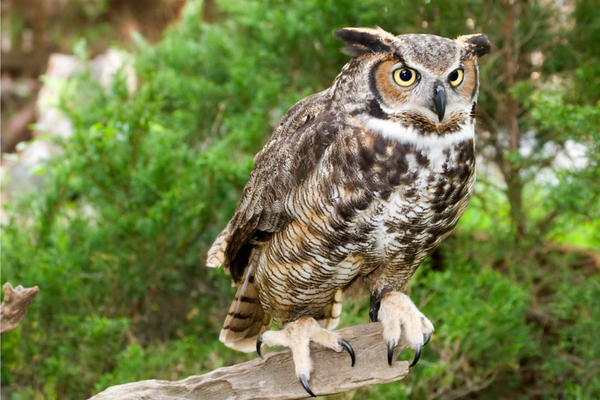
Tips for Birdwatchers On How To Attract Great Horned Owls
Since great horned owls are content to live in man-made structures, you can definitely attract them with a nesting box. So, this is definitely one way to attract these beautiful creatures to your backyard.
It’s important to have a large piece of property because they appreciate open spaces and big trees. They like perching on poles and trees, so it couldn’t hurt to add a poll to your backyard that they would enjoy perching on.
Remember, great horned owls are very fierce predators. You might not want them living in your backyard. They’ll kill and eat all of the skunks, rabbits, mice, squirrels, and other small to medium-sized prey. They have been known to hunt down cats and small dogs as well, so your family pets might not be safe while having them around.
Related article: Snowy Owl: Bird Identification, Habits, Facts, Nesting
Conservation Status
The great horned owl is designated as a Least Concern. This means there are a plentiful amount of great horned owls remaining in the world. The species isn’t vulnerable or in any danger of becoming extinct.
Fun & Interesting Facts
- They are aggressive predators. Great horned owls have the ability to take down larger prey including Prairie Falcons, Peregrine Falcons, ospreys, and other large birds.
- They have extreme strength when clenching their talons. To open them requires 28 pounds of pressure to get them to unclench.
- Crows tend to mob great horned owls. You’ll know it’s happening if you hear many American crows cawing loudly. They have been known to harass these owls for hours at a time. Why? Great horned owls are the most dangerous predator to crows.
- Female great horned owls are larger than their male counterparts.
- Male great horned owls have larger voice boxes and deeper voices than their female counterparts.
- These owls have very soft feathers. They are used to insulate against cold weather while flying as they pursue their prey.
- They have short and wide wings. This makes it easier to maneuver in the forest amongst the trees.
- They have very large eyes with wide-open pupils. This helps them see at night in the dark. Their retinas also contain rod cells, which promotes fantastic night vision.
Explore More Species in This Family
- Short-Eared Owl
- Long-Eared Owl
- Flammulated Owl
- Western Screech-Owl
- Burrowing Owl
- Elf Owl
- Northern Saw-Whet Owl
- Great Gray Owl
- Eastern Screech-Owl
- Snowy Owl
- Northern Hawk Owl
- Barred Owl
- Spotted Owl
- Boreal Owl
- Northern Pygmy-Owl
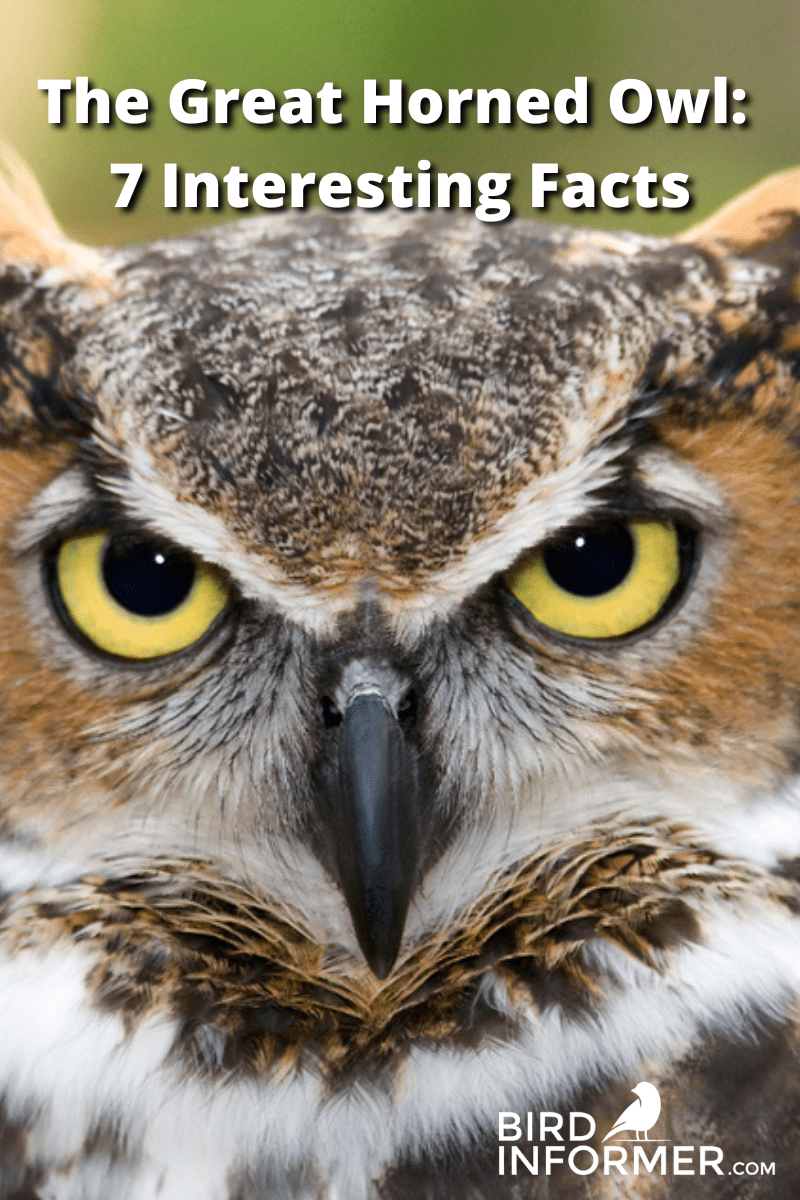
from BirdInformer.com https://ift.tt/HGTnJXl

No comments:
Post a Comment